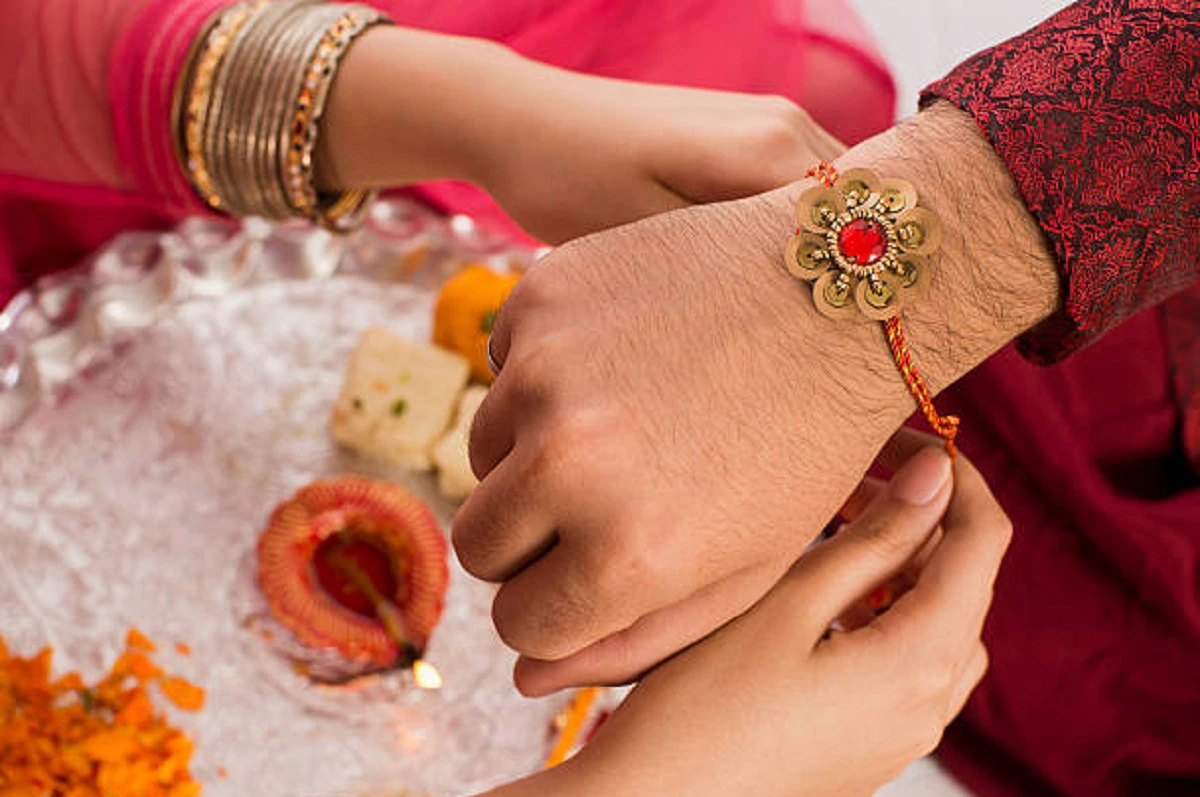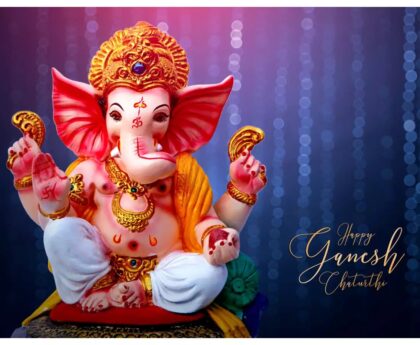The term “Raksha Bandhan” is derived from two words in Sanskrit: “Raksha” meaning protection, and “Bandhan” meaning bond or tie. Therefore, the literal meaning of Raksha Bandhan is “the bond of protection.” This term encapsulates the essence of the festival, which revolves around the bond of love, care, and protection shared between brothers and sisters. The sister ties a rakhi (a decorative thread) around her brother’s wrist, symbolizing her love and prayers for his well-being, while the brother promises to protect and support his sister throughout their lives.
During Raksha Bandhan, sisters tie a decorative thread called a “rakhi” around their brothers’ wrists as a symbol of their love and affection. In return, brothers offer gifts or tokens of appreciation to their sisters and promise to protect them from any harm or difficulties. The rakhi thread is not just a physical adornment; it signifies the emotional connection and the lifelong commitment of siblings to support and care for each other.
Raksha Bandhan is more than just a celebration of biological siblings. It also extends to cousins, close friends, and even neighborly relationships where the bond is akin to that of siblings. The festival promotes harmony and strengthens family and social ties.
The ritual of Rakhi has historical and mythological significance as well. There are various legends associated with the festival, such as the story of Lord Krishna and Draupadi from the epic Mahabharata, and the tale of Queen Karnavati and Emperor Humayun from historical accounts.
On this day, families come together, exchange blessings, and partake in festive meals. Traditional sweets, gifts, and clothing are commonly exchanged during the celebration. The festival holds cultural importance and is celebrated with enthusiasm across India and by Indian communities around the world.
When is Raksha Bandhan Celebrated?
Raksha Bandhan is celebrated on the full moon day of the Hindu lunar month of Shravana. This usually falls in the months of July or August in the Gregorian calendar. The exact date varies from year to year based on the lunar calendar. It’s important to note that the Hindu calendar is different from the widely used Gregorian calendar, which is based on the solar year.
Here are some key points about Raksha Bandhan:
Date and Timing: Raksha Bandhan is usually celebrated on the full moon day of the Hindu lunar month of Shravana, which falls in the months of July or August. The timing of the festival can vary from year to year.
Rakhi: The central ritual of Raksha Bandhan involves the sister tying a rakhi—a decorative thread—around her brother’s wrist. The rakhi is a symbol of protection, love, and goodwill. It’s a sacred thread that represents the bond between siblings.
Prayers and Blessings: After tying the rakhi, sisters often perform a small prayer or ritual for the well-being and prosperity of their brothers. In return, brothers give gifts or sometimes a monetary token of appreciation to their sisters as a sign of their affection and commitment to protect them.
Siblings’ Promise: During Raksha Bandhan, brothers typically promise to protect their sisters from any harm and offer lifelong support. This promise symbolizes the emotional bond and responsibility they share.
Ceremonial Foods: Families often prepare special sweets and dishes for Raksha Bandhan. These traditional foods are shared among family members and guests as part of the festive celebrations.
Promoting Protection: The tying of the rakhi by the sister on her brother’s wrist symbolizes her plea for his protection and support. In return, the brother’s promise to safeguard his sister reflects his commitment to her well-being.
Cultural Tradition: Raksha Bandhan is deeply rooted in Indian culture and tradition. It’s a time-honored practice passed down through generations, fostering a sense of continuity and heritage.
Strengthening Family Ties: Raksha Bandhan encourages families to come together and celebrate their relationships. It’s a day to spend quality time with loved ones, share meals, and engage in festivities.
Cross-Generational Celebration: While the festival primarily celebrates the bond between siblings, it extends to cousins, close friends, and other relationships that resemble siblinghood. This inclusivity promotes harmony and unity among people.
Cultural Diversity: Raksha Bandhan is celebrated by people of various backgrounds and communities, reflecting the diversity of Indian culture. It’s a unifying festival that transcends religious boundaries.
Family Unity: The festival emphasizes the importance of family relationships and unity. It brings family members together, fostering a sense of togetherness and strengthening familial ties.
Symbol of Protection: The tying of the rakhi by the sister symbolizes her love and concern for her brother’s well-being. In return, the brother’s promise to protect his sister signifies the role of a guardian.
Social Cohesion: The festival has the potential to bridge gaps and promote understanding between individuals, families, and communities. It fosters a sense of empathy and shared values.
History / Origin of Raksha Bandhan Festival
The history and origin of the Raksha Bandhan festival are intertwined with various historical and mythological stories. While there is no single definitive account, the festival’s significance has evolved over time through these narratives. Here are some prominent stories associated with the origin of Raksha Bandhan:
Krishna and Draupadi:
One of the most well-known stories comes from the ancient Indian epic, the Mahabharata. According to the legend, when Lord Krishna cut his finger while handling sugarcane, Queen Draupadi tore a piece of her saree and tied it around his finger to stop the bleeding. Touched by her gesture, Krishna vowed to protect Draupadi in times of need. This event is often cited as the symbolic origin of the Raksha Bandhan tradition.
It highlights the deep bond of friendship and protection between a brotherly figure and a devotee. Here’s a summary of the story:
During the great Indian epic, the Mahabharata, there is an incident that took place in the court of the Kauravas. Draupadi, the wife of the Pandavas, was publicly humiliated and insulted by the Kauravas as a part of their larger schemes. Draupadi was in a helpless situation and was disheartened by the absence of support from her husband and others.
In her moment of distress, Draupadi fervently prayed to Lord Krishna for help and protection. She tied a piece of cloth from her saree around her wrist and raised it to the heavens, seeking Krishna’s intervention.
Moved by her devotion and her call for help, Lord Krishna immediately responded. He made the cloth she tied around her wrist infinitely long, which protected her modesty and honor. He stood by her side and ensured that her dignity was upheld.
This episode is often cited as a pivotal moment in the Mahabharata, demonstrating Lord Krishna’s unwavering support for Draupadi and his immediate response to her plea. This story is also linked to the concept of Raksha Bandhan, as it symbolizes the protective bond that exists between a brotherly figure (Krishna) and a sisterly figure (Draupadi).
The story of Krishna and Draupadi exemplifies the themes of divine intervention, protection, and the special bond of friendship and care. It’s a powerful narrative that has contributed to the cultural significance of Raksha Bandhan, reinforcing the idea that the festival is not limited to biological siblings but extends to all relationships that involve love, care, and protection.
Indra Dev and Sachi:
The story of Indra Dev and Sachi is another mythological tale associated with the origin of Raksha Bandhan. While this story might not be as widely known as some of the others, it adds to the cultural significance of the festival. Here’s a brief overview of the story:
According to the Puranas (ancient Indian texts), Indra Dev, the king of the Devas (celestial beings), was facing a formidable challenge from the demons. The situation became so dire that he started losing his power and kingdom. Seeing this, his wife Sachi, also known as Indrani, approached Guru Brihaspati, the preceptor of the Devas, for guidance.
Sachi sought a solution to help her husband regain his strength and power. Guru Brihaspati advised her to tie a sacred thread around Indra’s wrist, which would serve as a protective charm and symbolize their bond. Sachi followed his advice and tied the thread during the auspicious time of Shravana Purnima.
The sacred thread, or rakhi, that Sachi tied to Indra is said to have invoked divine blessings and protection. As a result, Indra successfully defeated the demons and regained his position as the king of the Devas. This event is considered one of the earliest instances of the Raksha Bandhan tradition, where a sister ties a rakhi to her brother for his well-being and protection.
The story of Indra Dev and Sachi underscores the concept of protection, loyalty, and the strength of familial bonds. While this story might not be as widely known as others, it contributes to the cultural mosaic of Raksha Bandhan, highlighting the diverse narratives that have shaped the festival over time.
Yama and Yamuna:
Yama, the god of death, had a sister named Yamuna, who was the goddess of the sacred Yamuna River. Despite their contrasting roles, Yama cared deeply for his sister and was concerned about her well-being.
One day, Yama visited Yamuna to meet her. Touched by her brother’s visit, Yamuna welcomed him with warmth and affection. She performed the traditional rituals of aarti (a ritual of offering light) and applied a tilak (a ceremonial mark) on his forehead as a sign of her love and care for him.
Touched by his sister’s love and the special bond they shared, Yama was moved. He asked Yamuna if there was anything he could do for her in return. Yamuna expressed her concern for her brother’s well-being and wished for his protection and longevity.
Yama, deeply touched by his sister’s request, granted her a boon. He promised that anyone who receives a rakhi thread from his sister Yamuna and offered her protection in return would be blessed with his protection and longevity.
This story showcases the sacred and protective nature of the bond between a brother and a sister. It emphasizes the divine aspect of the Raksha Bandhan tradition, where the sister ties a rakhi around her brother’s wrist, symbolizing her love and prayers for his protection, and the brother vows to safeguard her in return.
The story of Yama and Yamuna adds depth to the cultural and spiritual significance of Raksha Bandhan, highlighting the enduring bond of love and protection that exists between siblings.
King Bali and Goddess Lakshmi:
The story of King Bali and Goddess Lakshmi is another significant tale associated with the festival of Raksha Bandhan. It highlights the relationship between a devotee and a deity, showcasing the values of devotion, humility, and protection. Here’s a summary of the story:
King Bali was a benevolent and powerful demon king who had gained control over the three worlds. He was known for his generosity and the ability to fulfill the wishes of his subjects. However, his increasing power and control became a concern for the gods, including Lord Indra.
To counter King Bali’s dominance, Lord Vishnu took the avatar of Vamana (a dwarf Brahmin) and approached King Bali’s kingdom. Vamana requested a piece of land that he could measure with three steps. Impressed by the humility and simplicity of the Brahmin, King Bali agreed.
As soon as King Bali granted the request, Vamana transformed into his divine form and covered the entire universe with three steps. With his first two steps, he covered the earth and the heavens. For his third step, there was no space left, so King Bali humbly offered his own head for Vamana to place his foot.
Touched by King Bali’s devotion and sacrifice, Lord Vishnu granted him a boon. King Bali requested that Lord Vishnu remain with him in his kingdom. Lord Vishnu agreed and became the guardian and protector of Bali’s kingdom.
Goddess Lakshmi, the consort of Lord Vishnu, was separated from her husband due to his presence in King Bali’s kingdom. She desired to return to Vishnu’s side. Observing this, she tied a rakhi around King Bali’s wrist and asked for a favor. King Bali was moved by her gesture and asked what she wanted. Goddess Lakshmi requested that her husband, Lord Vishnu, be released from his duty of guarding Bali’s kingdom.
Touched by Goddess Lakshmi’s request and understanding her desire, King Bali agreed to let Lord Vishnu return to his abode. As a token of his promise, he granted her a boon, ensuring that on the day of Shravana Purnima, Goddess Lakshmi would visit his kingdom and tie a rakhi on his wrist.
This story underscores the themes of devotion, sacrifice, and the bond of protection that Raksha Bandhan represents. It also showcases the interplay between gods, demons, and the divine forces of the universe. The story of King Bali and Goddess Lakshmi adds depth and cultural richness to the celebration of Raksha Bandhan.
Rani Karnavati and Emperor Humayun:
A historical story revolves around Rani Karnavati, the queen of Mewar, who sent a rakhi to Emperor Humayun seeking his help to protect her kingdom from invasion. Touched by her plea, Humayun immediately marched to her aid and offered his protection.
These stories illustrate the themes of protection, care, and the bond between siblings. Over time, these themes became integral to the Raksha Bandhan festival, which celebrates the love and responsibility shared between brothers and sisters.
Raksha Bandhan’s history is rich and diverse, reflecting the cultural and mythological tapestry of India. While the specific origin may vary across regions and communities, the festival’s core message of sibling love, protection, and unity remains consistent.
Santoshi Maa and Lord Ganesha:
The story of Santoshi Maa and Lord Ganesha is a more recent addition to the mythology of Raksha Bandhan. It was popularised through a 1975 Bollywood movie titled “Jai Santoshi Maa,” which portrayed the story of the goddess Santoshi Maa and her connection with Lord Ganesha. While not part of ancient mythology, this narrative has become widely recognized and associated with the festival. Here’s a summary of the story:
According to the “Jai Santoshi Maa” narrative, once upon a time, the sons of Lord Ganesha—Shubha and Labha—expressed their desire to have a sister. Hearing their plea, Lord Ganesha created a daughter named Santoshi Maa from the divine flames.
Santoshi Maa, who embodies the concept of contentment and happiness, was cherished by Lord Ganesha’s sons. However, as time passed, she faced challenges and obstacles in her divine abode. Distressed by her difficulties, Santoshi Maa tied a sacred thread around her wrist and prayed for a solution.
Touched by her devotion and prayers, Lord Ganesha came to her rescue. He granted her the boon of happiness and prosperity, assuring that whoever observed a vow and tied a thread (rakhi) while worshipping Santoshi Maa on a specific day (Fridays) would receive her blessings and have their wishes fulfilled.
This story has contributed to the celebration of Raksha Bandhan in some regions, particularly in North India. On Fridays and during the festival of Raksha Bandhan, devotees of Santoshi Maa tie threads around their wrists as a mark of their devotion and seek her blessings for happiness, prosperity, and the fulfillment of their wishes.
It’s important to note that while the story of Santoshi Maa and Lord Ganesha may not be as ancient as some of the other tales, it has become a part of the cultural narrative surrounding Raksha Bandhan, reflecting the diverse interpretations and adaptations of the festival’s traditions over time.
These legends showcase themes of protection, devotion, sacrifice, and the bond between siblings. While some stories are rooted in ancient Hindu texts, others have gained prominence through cultural adaptations over time. Regardless of their origins, these legends collectively contribute to the cultural and spiritual significance of Raksha Bandhan, emphasizing the values of love, care, and support among family members and loved ones.




